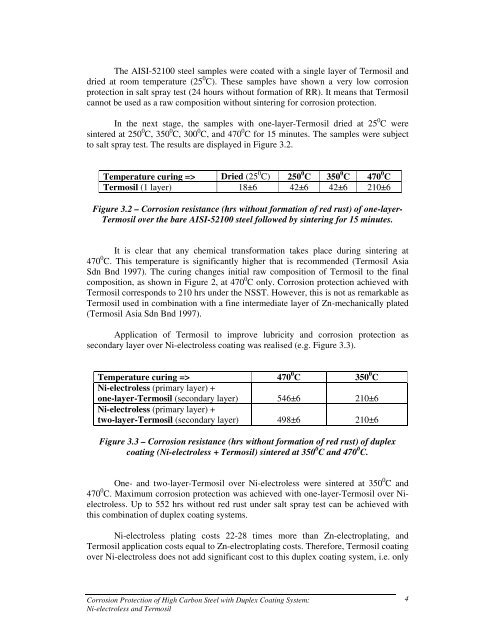Corrosion Protection of High Carbon Steel with Duplex Coating ...
Corrosion Protection of High Carbon Steel with Duplex Coating ...
Corrosion Protection of High Carbon Steel with Duplex Coating ...
You also want an ePaper? Increase the reach of your titles
YUMPU automatically turns print PDFs into web optimized ePapers that Google loves.
The AISI-52100 steel samples were coated <strong>with</strong> a single layer <strong>of</strong> Termosil and<br />
dried at room temperature (25 0 C). These samples have shown a very low corrosion<br />
protection in salt spray test (24 hours <strong>with</strong>out formation <strong>of</strong> RR). It means that Termosil<br />
cannot be used as a raw composition <strong>with</strong>out sintering for corrosion protection.<br />
In the next stage, the samples <strong>with</strong> one-layer-Termosil dried at 25 0 C were<br />
sintered at 250 0 C, 350 0 C, 300 0 C, and 470 0 C for 15 minutes. The samples were subject<br />
to salt spray test. The results are displayed in Figure 3.2.<br />
Temperature curing => Dried (25 0 C) 250 0 C 350 0 C 470 0 C<br />
Termosil (1 layer) 18±6 42±6 42±6 210±6<br />
Figure 3.2 – <strong>Corrosion</strong> resistance (hrs <strong>with</strong>out formation <strong>of</strong> red rust) <strong>of</strong> one-layer-<br />
Termosil over the bare AISI-52100 steel followed by sintering for 15 minutes.<br />
It is clear that any chemical transformation takes place during sintering at<br />
470 0 C. This temperature is significantly higher that is recommended (Termosil Asia<br />
Sdn Bnd 1997). The curing changes initial raw composition <strong>of</strong> Termosil to the final<br />
composition, as shown in Figure 2, at 470 0 C only. <strong>Corrosion</strong> protection achieved <strong>with</strong><br />
Termosil corresponds to 210 hrs under the NSST. However, this is not as remarkable as<br />
Termosil used in combination <strong>with</strong> a fine intermediate layer <strong>of</strong> Zn-mechanically plated<br />
(Termosil Asia Sdn Bnd 1997).<br />
Application <strong>of</strong> Termosil to improve lubricity and corrosion protection as<br />
secondary layer over Ni-electroless coating was realised (e.g. Figure 3.3).<br />
Temperature curing => 470 0 C 350 0 C<br />
Ni-electroless (primary layer) +<br />
one-layer-Termosil (secondary layer) 546±6 210±6<br />
Ni-electroless (primary layer) +<br />
two-layer-Termosil (secondary layer) 498±6 210±6<br />
Figure 3.3 – <strong>Corrosion</strong> resistance (hrs <strong>with</strong>out formation <strong>of</strong> red rust) <strong>of</strong> duplex<br />
coating (Ni-electroless + Termosil) sintered at 350 0 C and 470 0 C.<br />
One- and two-layer-Termosil over Ni-electroless were sintered at 350 0 C and<br />
470 0 C. Maximum corrosion protection was achieved <strong>with</strong> one-layer-Termosil over Nielectroless.<br />
Up to 552 hrs <strong>with</strong>out red rust under salt spray test can be achieved <strong>with</strong><br />
this combination <strong>of</strong> duplex coating systems.<br />
Ni-electroless plating costs 22-28 times more than Zn-electroplating, and<br />
Termosil application costs equal to Zn-electroplating costs. Therefore, Termosil coating<br />
over Ni-electroless does not add significant cost to this duplex coating system, i.e. only<br />
<strong>Corrosion</strong> <strong>Protection</strong> <strong>of</strong> <strong>High</strong> <strong>Carbon</strong> <strong>Steel</strong> <strong>with</strong> <strong>Duplex</strong> <strong>Coating</strong> System:<br />
Ni-electroless and Termosil<br />
4

















